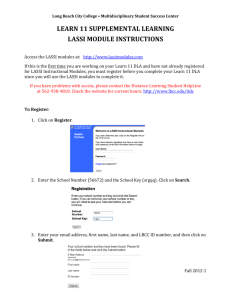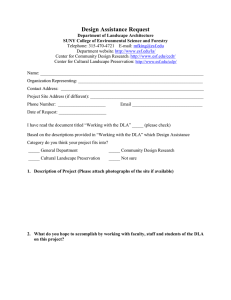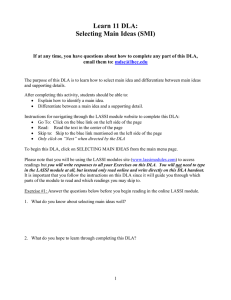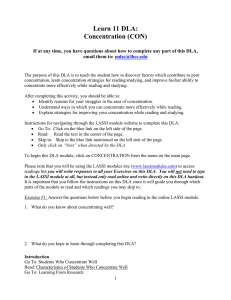INP: Information Processing
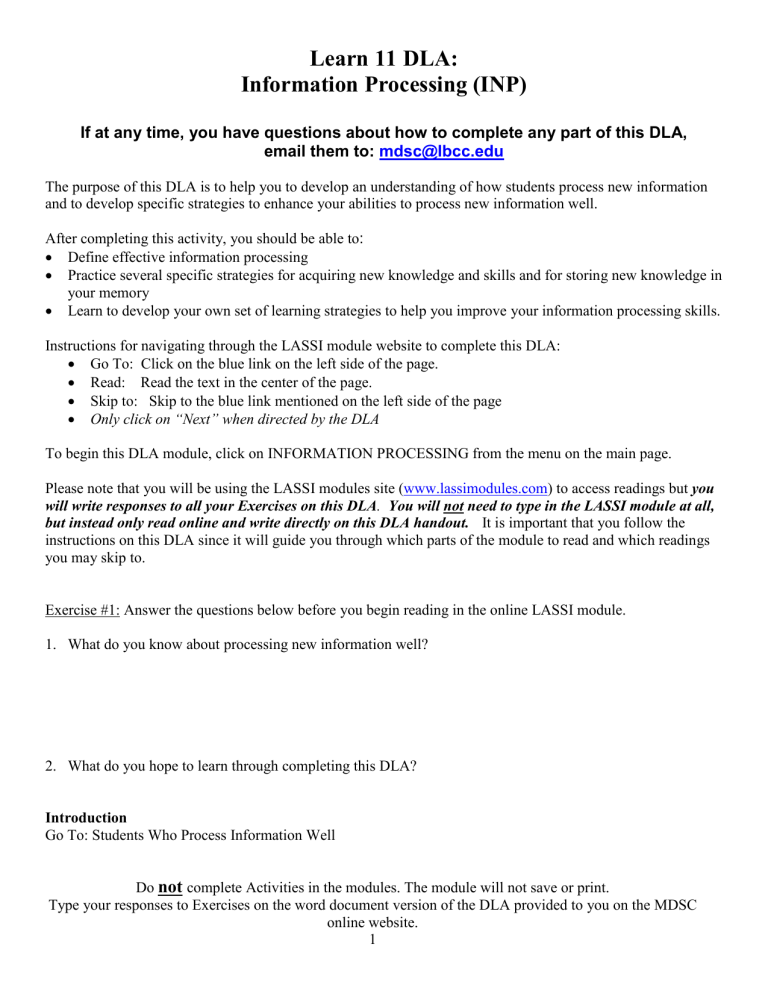
Learn 11 DLA:
Information Processing (INP)
If at any time, you have questions about how to complete any part of this DLA, email them to: mdsc@lbcc.edu
The purpose of this DLA is to help you to develop an understanding of how students process new information and to develop specific strategies to enhance your abilities to process new information well.
After completing this activity, you should be able to :
Define effective information processing
Practice several specific strategies for acquiring new knowledge and skills and for storing new knowledge in your memory
Learn to develop your own set of learning strategies to help you improve your information processing skills.
Instructions for navigating through the LASSI module website to complete this DLA:
Go To: Click on the blue link on the left side of the page.
Read: Read the text in the center of the page.
Skip to: Skip to the blue link mentioned on the left side of the page
Only click on “Next” when directed by the DLA
To begin this DLA module, click on INFORMATION PROCESSING from the menu on the main page.
Please note that you will be using the LASSI modules site ( www.lassimodules.com
) to access readings but you
will write responses to all your Exercises on this DLA. You will not need to type in the LASSI module at all, but instead only read online and write directly on this DLA handout.
It is important that you follow the instructions on this DLA since it will guide you through which parts of the module to read and which readings you may skip to.
Exercise #1: Answer the questions below before you begin reading in the online LASSI module.
1.
What do you know about processing new information well?
2.
What do you hope to learn through completing this DLA?
Introduction
Go To: Students Who Process Information Well
Do not complete Activities in the modules. The module will not save or print.
Type your responses to Exercises on the word document version of the DLA provided to you on the MDSC online website.
1
3.
1.
2.
Go To and Read: Characteristics Of Students Who Process New Information Well. Do not read the last paragraph.
Go To: Learning From Research
Read: What Research Tells Us About Students Who Process New Information Well
Go To: Learning From Research
Read: What Research Tells Us About Students Who Do Not Process New Information Well
Exercise #2: Of the characteristics of students who process new information well and do not process new information well you just read about, write three (3) that you identify with.
What is Information Processing?
Go To and Read: What Is Information Processing?
Go To: Questions To Guide Your Thinking
Read: Questions To Guide Your Thinking As You Complete This Module
Go To: Making Information Meaningful
Read: Information Processing Strategies Make New Information Meaningful To You
Do not complete Activities in the modules. The module will not save or print.
Type your responses to Exercises on the word document version of the DLA provided to you on the MDSC online website.
2
Exercise # 3: Analyzing your information processing: Take a few minutes to think about how you presently process new information. Write your answers to the following questions:
1.
How many strategies can you name or describe for learning and understanding information from a textbook? List as many as you can below.
2.
When you are trying to learn new information, do your main strategies involve simply re-reading the material or re-reading your notes? Why or why not?
3.
Do you use the same strategies for learning material no matter what type of class it is or what type of material you are learning? Why or why not?
Go To: Importance Of Information Processing
Read: Points To Remember About Information Processing
Go To: Increasing Your Learning Strategies
Read: Increasing The Number Of Strategies That You Know And Use
Memory and Information Processing
Go To: Constructing Knowledge
Read: An Exercise At Constructing Knowledge
Click Next to try Exercise: Constructing Knowledge
Click Next again and answer Exercise below.
Exercise # 4. Write as many of the words as you can recall in the space below. Don't worry about guessing.
The words I can remember or guess are:
Do not complete Activities in the modules. The module will not save or print.
Type your responses to Exercises on the word document version of the DLA provided to you on the MDSC online website.
3
Go To: Constructing Knowledge
Read: An Exercise In Constructing Knowledge. Click on next to view second page Constructing Knowledge.
Go To and Read: The Memory Continuum
Go To: Processing New Information
Read: Deciding What To Do With New Information
Go To: Deciding How Long to Remember
Read: Deciding How Long To Remember New Information
Go To: Short Term Memory (Activity #5)
Read: Short Term Memory. Do not complete Activity #5 online. Read material only. Answer the Exercise below.
Exercise #5. Think about yourself and times when you have used simple repetition for learning. In the box below, describe some problems that might occur on an exam if you rely solely on memorizing.
Problems that might occur if I only use simple repetition to study for an exam:
Go To: Problems With Short-Term Memory
Read: Problems With Relying On Short-Term Memory
Go To: Longer-Term Memory (Activity #6)
Read: Longer-Term Memory. Do not answer Activity #6 online. Read material only. Answer the Exercise
2. below.
Exercise #6: Write three examples of memories you have that are stored in your long-term memory.
1.
3.
Go To: Examples: Longer-Term Memories
Read: Examples of Longer-Term Memories
Go To: Strategies: Learning Information
Read: Strategies for Learning Information
Do not complete Activities in the modules. The module will not save or print.
Type your responses to Exercises on the word document version of the DLA provided to you on the MDSC online website.
4
Rehearsal Strategies
Go To and Read: Active Rehearsal Strategies
Go To: Using Mnemonic Strategies
Read: Using Mnemonics (Artificial Memory Aids) For Active Rehearsal
Go To: First-Letter Method (Activity #7)
Read: First-Letter Method. First-Letter Method is often referred to as Acronyms and Acrostics.
Do not complete Activity #7 online. Read material only. Answer the Exercise below.
Exercise #7: Think of two times that you have used the first-letter method or where you could use this method in one or more of your classes. One of your examples can be from outside of your college classes. Provide the examples of the First-Letter Method (Acronym or Acrostic) below. If you can’t think of one, you may ask someone else (a fellow classmate, a tutor) or look in your book for an example to use.
1.
2.
Go To: Rhymes And Tunes (Activity #9)
Read: Rhymes And Tunes. Rhymes and Tunes are sometimes referred to as Auditory Cues. Do not complete
Activity #9 online. Read material only. Answer the Exercise below.
Exercise #8: Think of a time that you learned something (perhaps as a child) by learning a song, jingle, rhyme or rap. What was it?
Go To: Story Method (Activity #10)
Read: Story Method. Story Method is sometimes referred to as Extended Metaphor. Do not complete Activity
#10 online. Read material only. Answer the Exercise below.
Exercise # 9. Students who study electronics need to memorize the order of resistor code colors. This is a sequence of colors as follows:
Black, brown, red, orange, yellow, green, violet, grey, white.
Here is an example of how you might use the story method to remember these 10 colors in order:
Black bears and brown squirrels eat red apples and orange carrots under the yellow sun on the green grass next to violet flowers under the grey and white clouds in the sky.
Note that some of the words match the colors. The colors in the story are mentioned in the same order as the resistor code colors so that you can remember the colors in order.
Do not complete Activities in the modules. The module will not save or print.
Type your responses to Exercises on the word document version of the DLA provided to you on the MDSC online website.
5
How would you use the Story Method (Extended Metaphor) to remember the 10 colors in order?
Write your story here: Feel free to erase and rewrite as many times as you want.
Go To: Link Method (Activity #11)
Read: The Link Method. Do not complete Activity #11 online. Read material only.
Go To and Read: Section Summary
Elaboration Strategies, Part I
Go To: Defining Elaboration (Activity #12)
Read: Defining Elaboration. Do not complete Activity #12 online. Read material only.
Go To and Read: Elaboration Strategies
Go To: Associating New Material
Read: Associating New Material With Prior Knowledge
Go To: Forming Mental Images
Read: Forming Mental Images For Association (sometimes referred to as Visualization)
Exercise #10: Have you ever formed a mental image to remember something before? If so, describe the mental image you used. If not, when could you use this method?
Skip to the Elaboration Strategies, Part II section (click in the blue navigation section on the left).
Elaboration Strategies, Part II
Go To: Creating Analogies (Activity #17)
Read: Creating Analogies. Do not complete Activity #17 online. Read material only.
Go To: Creating & Answering Questions (Activity #18)
Read: Creating And Answering Questions About The Material. Do not complete Activity #18 online. Read material only. Answer the Exercise on the next page of the DLA.
Do not complete Activities in the modules. The module will not save or print.
Type your responses to Exercises on the word document version of the DLA provided to you on the MDSC online website.
6
Exercise # 11 Assume that you are given the following material from one of your textbooks. What questions would you ask that would help you to think critically about the material?
Textbook: United States History
Chapter 3: Forming a Government
Section 1: Weakness in the Articles of Confederation
Section 2: Shays Rebellion
Section 3: The Great Compromise
Section 4: Debate to the Ratification of the Constitution
Write your questions here:
Do you think that these questions would help you to learn the material from your textbook? Why or why not?
Go To: Applying New Knowledge (Activity #19)
Read: Applying Knowledge In New Situations. Do not complete Activity #19 online. Read material only.
Go To: Teaching Someone Else (Activity #20)
Read: Teaching Someone Else The Material. Do not complete Activity #20. Read material only. Answer the
Exercise below.
Exercise #12: Now that you have been introduced to several elaboration strategies, which three (3) are you most likely to use? Why? When might you use each of these to help you retain information?
1.
Do not complete Activities in the modules. The module will not save or print.
Type your responses to Exercises on the word document version of the DLA provided to you on the MDSC online website.
7
3.
2.
Organizational Strategies
Go To and Read: Organizational Strategies
Go To: Dividing Into Meaningful Parts (Activity #21)
Read: Dividing The Material Into Meaningful Parts. This technique is sometimes referred to as Chunking. Do not complete Activity #21 online.
Go To: Hierarchical Relationships (Activity #22)
Read: Identifying Hierarchical Relationships Within The Material. Do not complete Activity #22 online. Read material only.
One method for identifying hierarchical relationships within the material is using a Study Matrix. Here is an example Study Matrix about the human muscular system.
Muscle
Principle Muscles of the Body Study Matrix
Function Insertion Origin Notes
1. Frontal
2. Trapezius
3. Deltoid
4. Biceps brachii
Do not complete Activities in the modules. The module will not save or print.
Type your responses to Exercises on the word document version of the DLA provided to you on the MDSC online website.
8
5. Triceps brachii
Go To: Diagramming And Outlining (Activity #23)
Read: Diagramming And Outlining The Information. Do not complete Activity #23 online. Read material only.
Go To: Classifying And Categorizing (Activity #24)
Read: Classifying Or Categorizing The Material. Do not complete Activity #24 online. Read material only.
Answer the Exercise below.
Exercise #13: Think of one course you are taking this semester. Choose one organization strategy that would help you study and learn that material more successfully. Why did you choose that strategy?
Using Learning Strategies
Go To and Read: Fluency and Flexibility
Go To and Read: Developing A Repertoire Of Strategies
Exercise #14.
Suppose you have to write a 500-word essay on a topic in your history class. What are three (3) strategies you might use to accomplish this task. Why did you choose these three?
1.
2.
3.
Go To and Read: Selecting Appropriate Strategies
Go To: Working Hard Vs. Working Smart
Read: Working Hard Versus Working Smart
Exercise #15.
1. Think about a time when you worked hard but not smart. Give a brief description of the situation, the strategies that you used, and the results of using these strategies.
Do not complete Activities in the modules. The module will not save or print.
Type your responses to Exercises on the word document version of the DLA provided to you on the MDSC online website.
9
2.
How would you approach that same situation today so that you could work smart, but not hard?
Go To and Read: Section Summary
Summary
Go To and Read: Suggestions For Improving Your Information Processing
Go To: Suggestions From Other Students
Read: Suggestions From Other Students For Improving Your Information Processing
Exercise #16: After having read the Suggestions from Other Students reading, answer the questions below.
1. Which one suggestion could you use this semester?
2. In which class or situation?
Do not complete Activities in the modules. The module will not save or print.
Type your responses to Exercises on the word document version of the DLA provided to you on the MDSC online website.
10
Exercise #17: Now that you have completed this activity, what three (3) strategies from this DLA do you consider most important to your success as a student?
1.
2.
3.
Choose one (1) of those three strategies that you can apply immediately to your life or to your coursework.
How you will apply this strategy this semester?
Congratulations! You have completed part of your supplemental learning assignment and have learned about how your attitudes can affect you as a student and how to create and revise goals. To receive credit for completing this assignment, you will participate in an online follow-up session with a Center staff member. Go to the “Follow-up Sessions” tab on the Multidisciplinary Student Success Center Online Supplemental Learning
Assistance site: http://webenhanced.lbcc.edu/mdssc/SLA/ to learn how to schedule your online appointment with a Center staff member.
Do not complete Activities in the modules. The module will not save or print.
Type your responses to Exercises on the word document version of the DLA provided to you on the MDSC online website.
11
